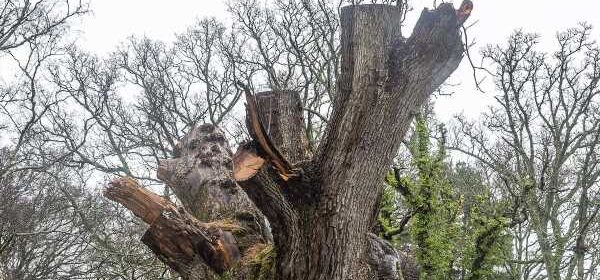Historic tree has branches pruned to save it from being cut down

Dead historic tree that has stood since before the reign of King Henry VIII and the birth of William Shakespeare is reduced in height and has had its branches pruned to save it from being cut down
- The King Oak is 600 years old and stands in the New Forest
A historic tree that is older than the reign of King Henry VIII and William Shakespeare’s plays has been saved from the chop.
The mighty 600-year-old specimen in the New Forest, known as the King Oak, was sadly declared dead this year after it failed to come into leaf.
Because the huge tree stands next to a public highway in the New Forest and there was a risk its decaying branches would snap off and hit passing vehicles, it faced being axed.
But conservationists were reluctant to remove the dead oak from the local landscape and came up with a plan to save it.
Specialist work has now been carried out to prune back the trunk and branches, taking the tree from 42ft to 23ft in height which means it is now wider than it is tall.
A historic tree that is older than the reign of King Henry VIII and William Shakespeare’s plays has been saved from the chop
The mighty 600-year-old specimen, known as the King Oak, was sadly declared dead this year after it failed to come into leaf. Above: The tree before it was reduced in size
The tree in June 2015. Conservationists were reluctant to remove the dead oak from the local landscape and came up with a plan to save it
Treemenders, a local tree contractor, made cuts intended to emulate storm damage, called veteranisation, which gives a natural finish.
The King Oak will now become a monument to nature as well as continuing to provide a vital habitat for birds, bats, insects and lichens.
James Palmer, tree officer at the New Forest National Park Authority (NPA) said: ‘Being in such a busy public space, the tree needed pruning to safely retain what we see today.
‘While keeping the deadwood in place is favourable, we had to consider any potential damage or injury caused by falling branches.
‘We worked with the owner of the tree, a local private estate, encouraging them to retain the ancient oak, and provided management advice for other options rather than to just fell it as was initially proposed.
‘The work to remove a large quantity of deadwood and dead branch tips is known as ‘stag heading’.
The King Oak will now become a monument to nature as well as continuing to provide a vital habitat for birds, bats, insects and lichens
James Palmer, tree officer at the New Forest National Park Authority (NPA) said: ‘Being in such a busy public space, the tree needed pruning to safely retain what we see today
‘We are pleased to help retain a portion of the King Oak, which will remain an important cultural landmark and help support hundreds of other plant and animal species for many years to come.
‘It’s a great example of the importance of managing ancient and veteran trees and collaborating with different people to protect them for future generations.’
The New Forest has one of the highest concentrations of ancient trees in western Europe.
On the opposite side of the road to the King Oak is an older tree known as the Queen Oak.
That is said to be in a state of decay and Mr Palmer said they were now looking to retain that.
He said: ‘She’s older than the King and without intervention is at risk of collapse due to internal decay.’
Source: Read Full Article





